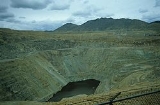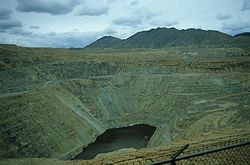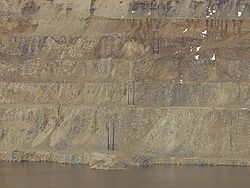
Berkeley Pit
Encyclopedia
The Berkeley Pit is a former open pit copper
mine
located in Butte, Montana
, United States
. It is one mile long by half a mile wide with an approximate depth of 1780 feet (542.5 m). It is filled to a depth of about 900 feet (274.3 m) with water that is heavily acidic (2.5 pH level), about the acidity of cola or lemon juice. As a result, the pit is laden with heavy metals
and dangerous chemicals
that leach from the rock, including arsenic
, cadmium
, zinc
, and sulfuric acid
.
The mine was opened in 1955 and operated by Anaconda Copper
and later by the Atlantic Richfield Company (ARCO), until its closure in 1982. When the pit was closed, the water pumps in the nearby Kelly shaft, at a depth of 3,800 feet, were turned off, and groundwater
from the surrounding aquifers began to slowly fill the pit, rising at about the rate of one foot a month. Since the pit closure in 1982, the level has risen to within 150 feet of the natural groundwater level.
The pit and its water present a serious environmental problem because the water, with dissolved oxygen, allows pyrite
and sulfide minerals in the ore and wall rocks to decay, releasing acid
. When the pit water level eventually reaches the natural water table, estimated to occur by around 2020, the pit water will reverse flow back into surrounding groundwater, polluting into Silver Bow Creek which is the headwaters of Clark Fork River. The acidic water in the pit carries a heavy load of dissolved heavy metals. In fact, the water contains so much dissolved metal (up to 187 ppm Cu
) that some material is mined directly from the water.
In the 1990s plans were devised for solving the groundwater problem. Water flowing into the pit has been diverted to slow the rise of the water level. Plans have been made for more extensive treatment in the future. The Berkeley Pit has since become one of the largest Superfund sites.
The pit is currently a tourist attraction, with an adjacent gift shop. A $2 admission fee is charged to go out on the viewing platform.
 The underground Berkeley Mine was located on a prominent vein
The underground Berkeley Mine was located on a prominent vein
extending to the southeast from the main Anaconda vein system. When open pit mining operations began in July 1955, near the Berkeley Mine shaft, the older mine gave its name to the pit. The open-pit style of mining superseded underground operations because it was far more economical and much less dangerous than underground mining.
Within the first year of operation, the pit extracted 17,000 tons of ore per day at a grade of 0.75% copper. Ultimately, about 1,000,000,000 tons of material was mined from the Berkeley Pit. Copper was the principal metal produced, although other metals were also extracted, including silver
and gold
.
Two communities and much of Butte's previously crowded east side were consumed by land purchases to expand the pit. The Anaconda Company bought the homes, businesses and schools of the working-class communities of Meaderville, East Butte, and McQueen, east of the pit site. Many of these homes were either destroyed, buried, or moved to the southern end of Butte. Residents were compensated at market value for their lost property.

 In 1995, a flock of migrating snow geese landed in the Berkeley Pit water and died, with 342 carcasses recovered. ARCO
In 1995, a flock of migrating snow geese landed in the Berkeley Pit water and died, with 342 carcasses recovered. ARCO
, the custodian of the pit, denied that the toxic water caused the death of the geese, attributing the deaths to an acute aspergillosis
infection that may have been caused by a grain fungus, as substantiated by Colorado State University
necropsy findings. These findings were disputed by the State of Montana on the basis of its own lab tests. Necropsies showed their insides were lined with burns and festering sores from exposure to high concentrations of copper, cadmium, and arsenic.
The most recent development in the clean-up was the construction of a treatment plant on Horseshoe Bend. This facility treats and diverts water coming from the Horseshoe Bend flow. In addition, it will be able to treat the existing Berkeley Pit water in 2018, or whenever the water level hits the critical point of 5410 feet (1,649 m) above sea level
. This number was set by federal order and is intended to protect the ground water from being contaminated by the water in the pit.
The Berkeley Pit is on the federal Superfund
site list.
Copper
Copper is a chemical element with the symbol Cu and atomic number 29. It is a ductile metal with very high thermal and electrical conductivity. Pure copper is soft and malleable; an exposed surface has a reddish-orange tarnish...
mine
Mining
Mining is the extraction of valuable minerals or other geological materials from the earth, from an ore body, vein or seam. The term also includes the removal of soil. Materials recovered by mining include base metals, precious metals, iron, uranium, coal, diamonds, limestone, oil shale, rock...
located in Butte, Montana
Butte, Montana
Butte is a city in Montana and the county seat of Silver Bow County, United States. In 1977, the city and county governments consolidated to form the sole entity of Butte-Silver Bow. As of the 2010 census, Butte's population was 34,200...
, United States
United States
The United States of America is a federal constitutional republic comprising fifty states and a federal district...
. It is one mile long by half a mile wide with an approximate depth of 1780 feet (542.5 m). It is filled to a depth of about 900 feet (274.3 m) with water that is heavily acidic (2.5 pH level), about the acidity of cola or lemon juice. As a result, the pit is laden with heavy metals
Heavy metals
A heavy metal is a member of a loosely-defined subset of elements that exhibit metallic properties. It mainly includes the transition metals, some metalloids, lanthanides, and actinides. Many different definitions have been proposed—some based on density, some on atomic number or atomic weight,...
and dangerous chemicals
Poison
In the context of biology, poisons are substances that can cause disturbances to organisms, usually by chemical reaction or other activity on the molecular scale, when a sufficient quantity is absorbed by an organism....
that leach from the rock, including arsenic
Arsenic
Arsenic is a chemical element with the symbol As, atomic number 33 and relative atomic mass 74.92. Arsenic occurs in many minerals, usually in conjunction with sulfur and metals, and also as a pure elemental crystal. It was first documented by Albertus Magnus in 1250.Arsenic is a metalloid...
, cadmium
Cadmium
Cadmium is a chemical element with the symbol Cd and atomic number 48. This soft, bluish-white metal is chemically similar to the two other stable metals in group 12, zinc and mercury. Similar to zinc, it prefers oxidation state +2 in most of its compounds and similar to mercury it shows a low...
, zinc
Zinc
Zinc , or spelter , is a metallic chemical element; it has the symbol Zn and atomic number 30. It is the first element in group 12 of the periodic table. Zinc is, in some respects, chemically similar to magnesium, because its ion is of similar size and its only common oxidation state is +2...
, and sulfuric acid
Sulfuric acid
Sulfuric acid is a strong mineral acid with the molecular formula . Its historical name is oil of vitriol. Pure sulfuric acid is a highly corrosive, colorless, viscous liquid. The salts of sulfuric acid are called sulfates...
.
The mine was opened in 1955 and operated by Anaconda Copper
Anaconda Copper
Anaconda Copper Mining Company was one of the largest trusts of the early 20th century. The Anaconda was purchased by Atlantic Richfield Company on January 12, 1977...
and later by the Atlantic Richfield Company (ARCO), until its closure in 1982. When the pit was closed, the water pumps in the nearby Kelly shaft, at a depth of 3,800 feet, were turned off, and groundwater
Groundwater
Groundwater is water located beneath the ground surface in soil pore spaces and in the fractures of rock formations. A unit of rock or an unconsolidated deposit is called an aquifer when it can yield a usable quantity of water. The depth at which soil pore spaces or fractures and voids in rock...
from the surrounding aquifers began to slowly fill the pit, rising at about the rate of one foot a month. Since the pit closure in 1982, the level has risen to within 150 feet of the natural groundwater level.
The pit and its water present a serious environmental problem because the water, with dissolved oxygen, allows pyrite
Pyrite
The mineral pyrite, or iron pyrite, is an iron sulfide with the formula FeS2. This mineral's metallic luster and pale-to-normal, brass-yellow hue have earned it the nickname fool's gold because of its resemblance to gold...
and sulfide minerals in the ore and wall rocks to decay, releasing acid
Acid mine drainage
Acid mine drainage , or acid rock drainage , refers to the outflow of acidic water from metal mines or coal mines. However, other areas where the earth has been disturbed may also contribute acid rock drainage to the environment...
. When the pit water level eventually reaches the natural water table, estimated to occur by around 2020, the pit water will reverse flow back into surrounding groundwater, polluting into Silver Bow Creek which is the headwaters of Clark Fork River. The acidic water in the pit carries a heavy load of dissolved heavy metals. In fact, the water contains so much dissolved metal (up to 187 ppm Cu
Copper
Copper is a chemical element with the symbol Cu and atomic number 29. It is a ductile metal with very high thermal and electrical conductivity. Pure copper is soft and malleable; an exposed surface has a reddish-orange tarnish...
) that some material is mined directly from the water.
In the 1990s plans were devised for solving the groundwater problem. Water flowing into the pit has been diverted to slow the rise of the water level. Plans have been made for more extensive treatment in the future. The Berkeley Pit has since become one of the largest Superfund sites.
The pit is currently a tourist attraction, with an adjacent gift shop. A $2 admission fee is charged to go out on the viewing platform.
Early history and development

Vein (geology)
In geology, a vein is a distinct sheetlike body of crystallized minerals within a rock. Veins form when mineral constituents carried by an aqueous solution within the rock mass are deposited through precipitation...
extending to the southeast from the main Anaconda vein system. When open pit mining operations began in July 1955, near the Berkeley Mine shaft, the older mine gave its name to the pit. The open-pit style of mining superseded underground operations because it was far more economical and much less dangerous than underground mining.
Within the first year of operation, the pit extracted 17,000 tons of ore per day at a grade of 0.75% copper. Ultimately, about 1,000,000,000 tons of material was mined from the Berkeley Pit. Copper was the principal metal produced, although other metals were also extracted, including silver
Silver
Silver is a metallic chemical element with the chemical symbol Ag and atomic number 47. A soft, white, lustrous transition metal, it has the highest electrical conductivity of any element and the highest thermal conductivity of any metal...
and gold
Gold
Gold is a chemical element with the symbol Au and an atomic number of 79. Gold is a dense, soft, shiny, malleable and ductile metal. Pure gold has a bright yellow color and luster traditionally considered attractive, which it maintains without oxidizing in air or water. Chemically, gold is a...
.
Two communities and much of Butte's previously crowded east side were consumed by land purchases to expand the pit. The Anaconda Company bought the homes, businesses and schools of the working-class communities of Meaderville, East Butte, and McQueen, east of the pit site. Many of these homes were either destroyed, buried, or moved to the southern end of Butte. Residents were compensated at market value for their lost property.
Environmental effects


ARCO
Atlantic Richfield Company is an oil company with operations in the United States as well as in Indonesia, the North Sea, and the South China Sea. It has more than 1,300 gas stations in the western part of the United States. ARCO was originally formed by the merger of East Coast-based Atlantic...
, the custodian of the pit, denied that the toxic water caused the death of the geese, attributing the deaths to an acute aspergillosis
Aspergillosis
Aspergillosis is the name given to a wide variety of diseases caused by fungi of the genus Aspergillus. The most common forms are allergic bronchopulmonary aspergillosis, pulmonary aspergilloma and invasive aspergillosis. Most humans inhale Aspergillus spores every day...
infection that may have been caused by a grain fungus, as substantiated by Colorado State University
Colorado State University
Colorado State University is a public research university located in Fort Collins, Colorado. The university is the state's land grant university, and the flagship university of the Colorado State University System.The enrollment is approximately 29,932 students, including resident and...
necropsy findings. These findings were disputed by the State of Montana on the basis of its own lab tests. Necropsies showed their insides were lined with burns and festering sores from exposure to high concentrations of copper, cadmium, and arsenic.
The most recent development in the clean-up was the construction of a treatment plant on Horseshoe Bend. This facility treats and diverts water coming from the Horseshoe Bend flow. In addition, it will be able to treat the existing Berkeley Pit water in 2018, or whenever the water level hits the critical point of 5410 feet (1,649 m) above sea level
Sea level
Mean sea level is a measure of the average height of the ocean's surface ; used as a standard in reckoning land elevation...
. This number was set by federal order and is intended to protect the ground water from being contaminated by the water in the pit.
The Berkeley Pit is on the federal Superfund
Superfund
Superfund is the common name for the Comprehensive Environmental Response, Compensation, and Liability Act of 1980 , a United States federal law designed to clean up sites contaminated with hazardous substances...
site list.
Extremophiles
New fungal and bacterial species have been found to have adapted to the harsh conditions inside the pit. Intense competition for the limited resources caused these species to evolve the production of highly toxic compounds to improve survivability; natural products such as Berkeleydione, berkeleytrione and Berkelic acid have been isolated from these organisms which show selective activity against cancer cell lines. Some of these species ingest metals and are being investigated as an alternative means of cleaning the water.Important Dates
- 1994 – September, EPA/DEQ issue Record of Decision (ROD) for Butte Mine Flooding Operable Unit.
- 1996 – April, Montana Resources (MR) and ARCO divert Horseshoe Bend (HSB) drainage water away from Berkeley Pit to slow filling rate, per ROD.
- 2000 – July, MR suspends mining operations due to high energy costs; HSB water allowed to flow back into pit, increasing pit filling rate.
- 2002 – March, USEPA and Montana Department of Environmental Quality (MDEQ) enter into a Consent Decree with BP/ARCO and the Montana Resources Group (known as the Settling Defendants) for settlement of past and future costs for this site.
- 2002 – Fall, USEPA and MDEQ issue order for Settling Defendants to begin design of water treatment plant for HSB water. Settling Defendants issue contract and begin construction of treatment plant.
- 2003 – November, MR resumes mining operations.
- 2003 – November 17, HSB water treatment plant comes on line slowing pit filling rate.
Geography
The mine is at 46°00′56"N 112°30′37"W, at an altitude of 4698 feet (1432 m) above mean sea level.External links
- Berkeley Pit Photos from the Montana Department of Environmental Quality
- PitWatch
- ISS image of Berkeley Pit (dated August 2, 2006)
- Researchers Hope Creatures From Black Lagoon Can Help Fight Cancer - Wired NewsWired NewsWired News is an online technology news website, formerly known as HotWired, that split off from Wired magazine when the magazine was purchased by Condé Nast Publishing in the 1990s. Wired News was owned by Lycos not long after the split, until Condé Nast purchased Wired News on July 11, 2006...
- Berkeley Pit on Google Maps

